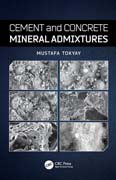
Supplementary cementing materials and other mineral admixtures are being used in increasing amounts in both cement and concrete. Their main technical benefits are that they enhance the workability of fresh concrete and the durability of hardened concrete. Indeed, they affect almost every property of the concrete. Their economic and ecological benefits may be just as significant, and their use can be expected to increase as concrete remains the most common construction material. Cement and Concrete Mineral Admixtures concentrates mostly on natural pozzolans, fly ashes, ground granulated blast furnace slag, silica fume and limestone powder, namely the most commonly used mineral admixtures. Others such as metakaolin, rice husk ash, expanded clays and shales are also discussed. Their chemical, mineralogical, and physical properties are outlined. The influence of mineral admixtures on the hydration of cementitious systems, and the properties of fresh and hardened concrete in which they are used are emphasized. International standards are reviewed. The basics of concrete mix proportioning with mineral admixtures are outlined. The possibilities of using mineral admixtures as constituents of special concretes such as self-compacting, reactive powder, roller-compacted concretes and special non-portland, low-cost, low-energy and/or low-CO2 cements such as alinite, calcium sulfoaluminate, and belitic cements and alkali-activated binders are also covered. The book is a comprehensive reference for senior undergraduate and graduate students and researchers in the fields of cement and concrete, and for cement and concrete practitioners.
- ISBN: 9781498716543
- Editorial: CRC PRESS LLC
- Encuadernacion: Tela
- Páginas: 318
- Fecha Publicación: 13/04/2016
- Nº Volúmenes: 1
- Idioma:
